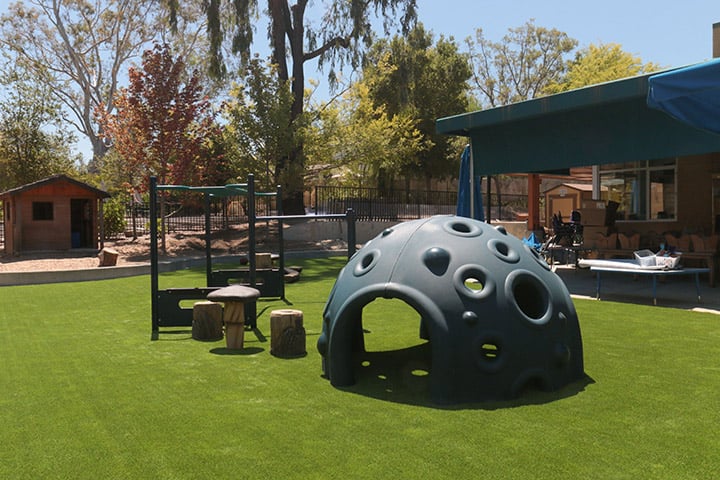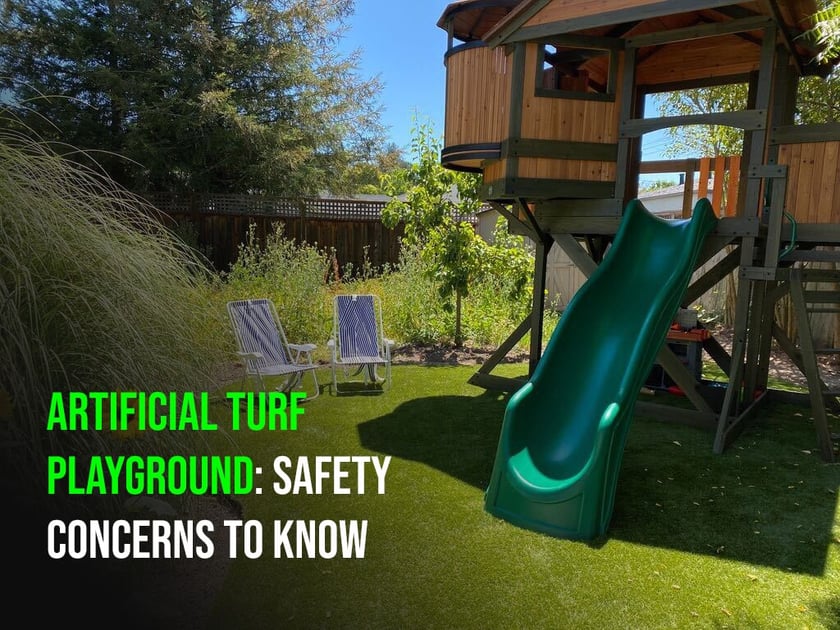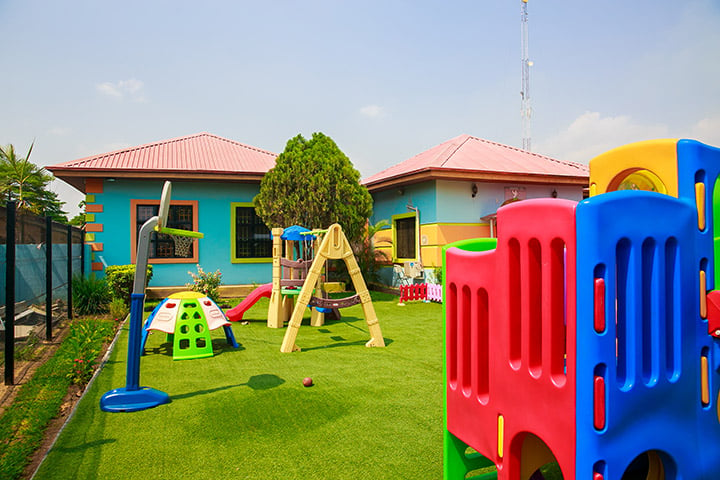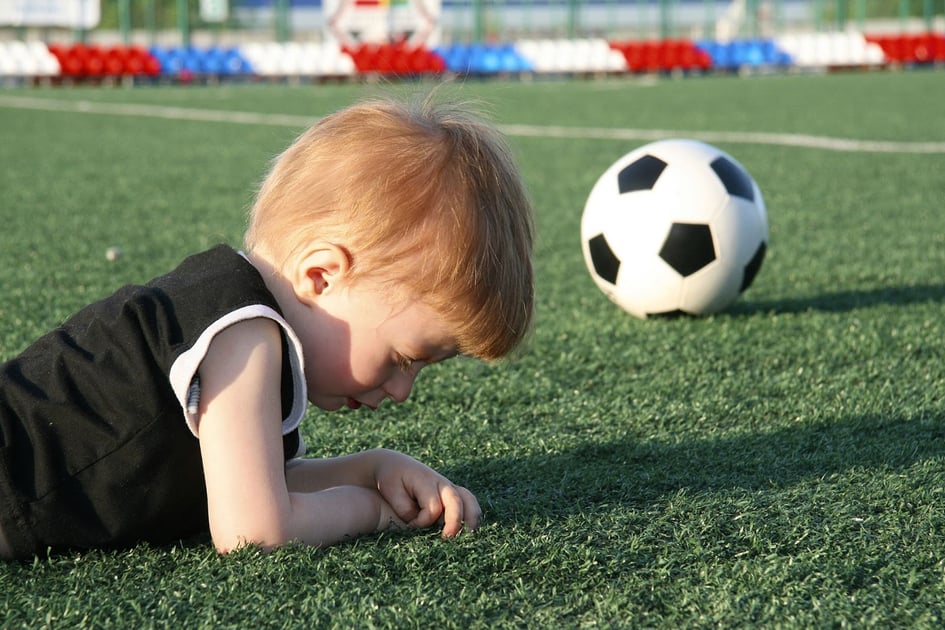Artificial Grass as Safety Surfacing for Your Residential Playground

No matter how much you try to protect kids on a residential playground, they will fall. That's part of playing and growing up. And as long as they're supervised, falls are generally nothing more than a rite of passage.
But what about when kids fall and there is no adult around to catch them? Are you sure they’re safe on your existing lawn?
Is Natural Grass Safe Enough for Residential Playgrounds?
Natural green grass may look wonderful around swings, slides and other playground equipment, but it's not the safest surface to land on. Below are a few reasons:
- Grass is not soft enough to cushion uneven landings.
- While grass is springy (to a degree) it does not provide adequate support for kids who fall.
- When wet, the soil compresses and becomes more hazardous than when dry.
- Grass is dangerously slippery when wet.
- The areas around playground equipment eventually become bare to reveal hard, packed dirt.
- Bare patches of ground can easily cause kids to slip and the mud that builds up on playground equipment can make it difficult to maintain their grip.
- There are other hazards of natural grass as well, such as triggering pollen allergies, harboring toxic weeds and insects and hiding holes and bumps.
In short, natural grass is not an ideal surface for playgrounds, parks and other areas where kids play.
What Are the Alternatives?
There are a few different types of materials that can be used as playground surfaces, including:
Rubber mulch
Pros:
- Softens falls
- Reduces noise pollution
- Absorbs moisture to keep surfaces from getting slippery
Cons: - Can be a choking hazard for small children if ingested
- Can fade in sunlight over time
- Can become matted and difficult to clean over time
Crumb rubber
Pros:
- Safer than natural grass
- Long-lasting and durable
Cons:
- Not aesthetically pleasing for some people (the black color may be undesirable)
- Can become hot when exposed to direct sunlight
- Requires more maintenance than other materials, such as regularly applying a sealant
Sand or pea gravel
Pros:
- Inexpensive
- Durable and long lasting
- Does not fade in sunlight
Cons:
- Can be a choking hazard for small children if ingested
- Can become dirty and difficult to clean over time
- Slippery when wet
- Can cause skin irritation if in contact with bare skin for long periods of time
Wood Chips or Shavings
Pros:
- Softens landings
- Aesthetically pleasing (can be used to cover bare patches of grass)
- Durable and long lasting
- Does not fade in sunlight
Cons:
- Can become matted and difficult to clean over time. Not ideal for play areas where lots of equipment (like swings and slides) are found in close proximity.
- Not aesthetically pleasing for some people (may be difficult to maintain appearance if there's a lot of foot traffic)
- Can cause skin irritation if in contact with bare skin for long periods of time
Hardscape like concrete or asphalt
Pros:
- Inexpensive to maintain
- Durable and long lasting
Cons:
- Can be a safety hazard if not properly maintained (uneven surfaces, cracks, holes)
- Not aesthetically pleasing for some people
- Slippery when wet
- Gets painfully hot in direct sunlight
While the alternatives above do have advantages, there are still significant cons to deal with.
For example, aside from being a choking hazard, sand also tends to harbor bacteria and foul odors. Concrete and asphalt can increase the risk of injuries because it doesn't provide adequate fall protection.
However, you do have another option: artificial grass.
Artificial Grass and Playground Safety
Artificial grass is one of the most cost-effective and convenient materials to use on playgrounds. It's soft, durable, easy to clean, non-irritating to skin (even when wet) and does not fade in sunlight.
What's more, the best synthetic turf makes playgrounds safer in several ways:
Excellent shock-absorbent properties
Playground turf is supported by foam padding, which makes it much softer than other surfaces, including natural grass. The shock-absorbent properties in artificial turf help reduce the risk of injury to children when they fall, especially from a height (e.g. from the top of jungle gym equipment).
Doesn't get worn out around playground equipment
Not only does playground turf have excellent shock-absorbent properties, it's pretty much engineered to resist wear and tear from daily use. While natural grass around play sets will get worn out quickly by movement of heavy play structures and foot traffic, artificial turf is designed to maintain its quality and safety over time.
Meets fall height requirements
ASTM F1292 is the safety standard that playground turf must meet in order to be considered safe for children. This standard requires any surface used in a playground to withstand a certain impact force without causing injury. ASTM F1292 artificial turf has been tested and proven to meet this requirement.
Where can you install artificial grass?
Playgrounds
Artificial grass is perfect for playgrounds because of its safety features, as well as the fact that it doesn't require any special maintenance. Aesthetics are also a plus, as most types of artificial turf have a realistic look and feel. No more brown patches or dirt spots – with synthetic turf, your playground will always look pristine.
Parks
Artificial turf can also be used in parks, where it serves as a more attractive and durable surface than natural grass. Like playgrounds, parks often see a lot of traffic, so artificial turf is ideal because it doesn't get worn down easily.
Schools
Installing artificial turf in schools is becoming an increasingly popular choice, as more and more schools are realizing the benefits of synthetic turf over natural grass. While natural grass can often be difficult to maintain, artificial turf requires little to no maintenance, making it a cost-effective option for schools. In addition, playground turf meets all safety standards required for school playgrounds.
Sports Courts
Artificial turf is also a great choice for sports courts. It provides a consistent and level playing surface, which is important for competitive games like soccer and basketball. The synthetic turf also helps reduce the risk of injuries, as it's much softer than concrete or asphalt.
Day Care Centers
Day care centers are another place where artificial turf can be a valuable addition. The soft surface is perfect for toddlers and young children, who are more prone to falls and injuries. In addition, artificial turf is easy to clean and doesn't harbor bacteria like natural grass can.
Indoor Play Areas
Artificial turf is also perfect for indoor play areas, where it can provide a safe flooring surface. This is particularly beneficial in shopping malls and other public places where children are present.
Frequently Asked Questions:
- Can synthetic turf be used as a substitute for natural grass?
Yes, artificial turf is becoming more and more common as an alternative to real grass. Not only does it provide a similar aesthetic appeal as natural grass, but it also doesn't require any special maintenance or upkeep. While you will still need to do some basic cleaning and maintenance for artificial turf, it's much easier than caring for natural grass.
- Is artificial grass for playgrounds safe for children?
Yes, high-quality playground turf meets fall safety standards required for child-safe surfaces. It has been tested and proven to withstand a certain impact force without causing injury. In addition, the soft surface is perfect for children who are more prone to falls and injuries. It's also non-toxic and hypoallergenic.
- Does artificial turf get hot?
Artificial turf is slightly warmer than natural grass, but it's still cooler than concrete or asphalt. It's important to keep in mind that the synthetic turf will absorb heat from the sun, so on particularly hot days it may be a bit warmer than usual, but nothing that will cause injury.
- Is artificial turf waterproof?
Yes, artificial turf is completely waterproof and can be used in areas that are exposed to rain or snow. It will not get wet or muddy like natural grass often does.
- How long does artificial turf last?
Artificial turf typically lasts anywhere from 8 to 20 years, but this depends on the amount of use and the quality of the turf.
Where Can I Get the Best Playground Grass in California?
Here at Heavenly Greens, of course! We offer one of the largest selection of premium, eco-friendly artificial turf for your playground, sports court, park or backyard.
Artificial grass for recreation and play is one of our specialties and we'd love to help you with whatever project you have in mind. Give us a call today at 844-287-5876 for a free consultation!
In the meantime, learn more about playground turf by downloading these FREE guides:











